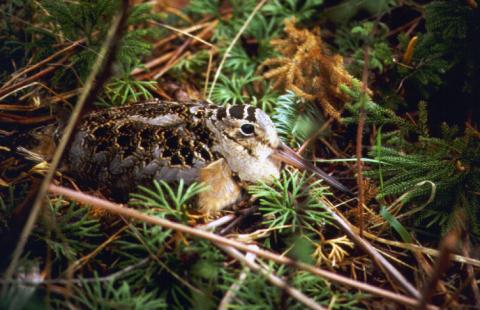American Woodcock

Taking the dogs out before sunrise this morning, I stepped out on the porch and was greeted with the nasally, almost frog-like peent of a woodcock. To me, that’s the first sign that spring has arrived, despite what the calendar says. Some years, the woodcock arrives in what are decidedly winter conditions. Last year in my neck of the woods, there were several feet of snow on the ground and temperatures were quite cold when the woodcock showed up. This year too there’s snow, but less of it and the temperatures are warmer. I worry that the birds won’t be able to find enough bare ground to search for earthworms, their favored food. My wife likes to tease me that I worry about this every year, but somehow, miraculously, they survive to return.
A Unique Bird
Woodcock belong to the shorebird family, but have adapted to upland life. They are a relatively small, stocky bird, about 10 – 11” if you count the beak. Woodcock aren’t showy – they are a blend of brown, gray, black, tan, and white. They are so well-camouflaged that it’s easy to almost step on one. If they didn’t fly out from under your feet, you probably wouldn’t see one on the ground at all.
Woodcock are well-built for searching for their favorite food, earthworms. They have a long bill – 2 ½” on a male, 2 ¾” on a female - which can be opened near the tip for grasping food while the majority of the beak is inserted into the ground. The woodcock’s eyes are arranged toward the back of the head, so they can watch for predators while searching for food. The brain is upside-down, to allow for the rearward eyes. In addition to worms, which make up about 60% of their diet, woodcock eat ants, beetles, crickets, caterpillars, grasshoppers, and insect larvae.
Courting Flight
One of the most interesting things about the woodcock is the males’ courting flight, or “sky dance” as naturalist Aldo Leopold called it. The male prefers an open area, at least a quarter-acre in size, to stage his flight. He starts out on the ground making the nasal “peent” sound. One writer describes it as sounding like “skre-e-e-e-nk”, which goes to show that you really have to hear it to know what it sounds like. A recording can be found at – https://ruffedgrousesociety.org/woodcock-facts/#audio. After doing this for a while, the bird takes off in a wide corkscrew pattern, making a whistling sound as it ascends. Once thought to be a vocalization, the whistling is actually made by air across the bird’s primary feathers. Reaching the top of his flight at 200 to 300 feet, the bird then makes a chirping sound before almost free-falling, fluttering like a leaf, to the ground. He usually lands in almost the exact same spot from which he began, then starts the sequence over again. Listening to and watching a woodcock’s courtship flight can provide good entertainment at dusk on a spring evening. If you’re in good woodcock habitat, it’s not uncommon to see several male birds performing, and you can almost see where their territories meet.
After mating, the female forms a rudimentary nest on the ground in thick cover, where she’ll lay three or four eggs. Three weeks later, assuming no nest predators have made off with the eggs, the young birds hatch. Woodcock chicks are precocial, meaning they are ready to leave the nest several hours after hatching. After two weeks they’re able to make short flights, and within a month are full grown. Woodcock productivity is relatively low, with only one brood per year. Fortunately, nesting is usually successful (60-75% success rate), and juveniles have high survival rates, likely a result of their superb camouflage and ability to sit absolutely still.
Migration
Come fall, woodcock migrate from their breeding grounds, which cover an area from the Lake States across to Maine and eastern Canadian provinces, down to Ohio and West Virginia. These short-winged birds migrate slowly and at altitudes of only about fifty feet, making short flights mixed with longer ones. Even at this low and slow pace, woodcock can travel up to 1500 miles to their wintering grounds across the South, from Virginia to Florida and to eastern Texas, with large numbers found in Louisiana.
Habitat
Good woodcock breeding habitat provides courtship sites, nesting and brood rearing cover, and roosting habitat. Open fields, meadows, or log landings bordered by dense young forest, especially aspen or alder on damp soils, provide a good mix.
Abandoned fields and pastures reverting to forest provide excellent woodcock habitat. The supply of abandoned farmland has dwindled, and many farms have instead been converted to housing and other development. Forests across much of New Hampshire have matured out of good woodcock habitat. Forces that used to create young forest, such as fire or beaver activity, are now limited or eliminated from the modern landscape. This leaves managed cutting of trees and shrubs as the main tools to create woodcock habitat. Regenerating mature aspen or alders through patch clearcutting are effective methods.
American woodcock are listed as a Species of Greatest Conservation Need in the New Hampshire Wildlife Action Plan. A number of programs and groups are dedicated to improving habitat for woodcock as well as the fifty or so additional species that rely on similar habitat. An American Woodcock Conservation Plan was developed to guide conservation across the woodcock’s range. With wildlife enthusiasts, biologists, and land managers focusing on improving and maintaining habitat, the spring ritual of watching the woodcock’s evening flight will be enjoyed for many years to come.
Sources:
American Woodcock Conservation Plan
Ruffed Grouse Society/American Woodcock Society www.ruffedgrousesociety.org
Young Forest Project – www.youngforest.org
Elman, Robert. (1987). The Hunter’s Field Guide. New York: Alfred A. Knopf.
Leopold, Aldo. A Sand County Almanac.
